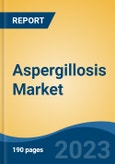Speak directly to the analyst to clarify any post sales queries you may have.
10% Free customizationThis report comes with 10% free customization, enabling you to add data that meets your specific business needs.
A primary driver of market growth is the increasing prevalence of immunocompromised individuals, fueled by rising rates of HIV/AIDS, organ transplants, and the expanded use of immunosuppressive therapies. This has led to a surge in demand for advanced diagnostic tools, including PCR assays, antigen testing, and imaging techniques such as CT scans, which enable early detection and prompt treatment.
Key Market Drivers
Rising Incidence of Immunocompromised Patients
The growth of the global aspergillosis market is significantly influenced by the rising number of immunocompromised patients. Individuals with conditions such as HIV/AIDS, those undergoing organ transplants, and patients receiving immunosuppressive therapies are particularly vulnerable to Aspergillus-related infections. In 2023, approximately 39.9 million people globally were living with HIV, with 1.3 million new infections reported that year. In the United States, an estimated 3% of adults are immunocompromised due to immune-affecting conditions or treatments. Additionally, 172,409 organ transplants were conducted worldwide in 2023, a 9.5% increase from the previous year. These statistics underscore the growing population of immunocompromised individuals, driving demand for diagnostics and treatments for infections like aspergillosis.Studies also show that immunocompromised patients face a heightened risk of severe infections, including those caused by SARS-CoV-2, highlighting the need for specialized care and preventive strategies. This trend emphasizes the need for tailored therapies and enhanced healthcare infrastructure to meet the unique needs of these patients, further propelling market expansion in the aspergillosis sector.
Key Market Challenges
Limited Awareness and Underdiagnosis
A significant challenge faced by the global aspergillosis market is the lack of awareness and underdiagnosis of Aspergillus-related infections. Despite the severe health risks associated with aspergillosis, it remains relatively unknown outside specialized medical circles. Many healthcare professionals, and the general public, are unfamiliar with the symptoms and risks of this fungal infection, which can often mimic other respiratory conditions, leading to misdiagnosis or delays in diagnosis. This lack of timely diagnosis can result in suboptimal or incorrect treatment, affecting patient outcomes and hindering market growth.Furthermore, underdiagnosis - an issue stemming from limited awareness - poses a serious concern. Without early intervention, aspergillosis can progress from a treatable condition to a life-threatening disease, particularly in immunocompromised individuals. The absence of widespread educational campaigns means that high-risk populations, such as organ transplant recipients or those undergoing immunosuppressive therapies, may not receive proper screening or information. These challenges create missed opportunities for market development and the timely delivery of critical treatments.
Key Market Trends
Immunomodulatory Therapies
Immunomodulatory therapies are emerging as a key growth driver in the global aspergillosis market. These therapies, designed to modulate and enhance the immune response, offer a promising adjunctive approach to managing aspergillosis, particularly in immunocompromised individuals. For patients with weakened immune systems - such as transplant recipients, chemotherapy patients, and those with underlying immunodeficiencies - the risk of invasive aspergillosis is significantly elevated. Immunomodulatory agents like granulocyte colony-stimulating factors (G-CSF) and interferon-gamma are being studied for their potential to stimulate the immune system and help patients better combat fungal infections.Clinical trials have demonstrated that immunomodulatory therapies, when used alongside traditional antifungal treatments, can significantly improve patient outcomes by enhancing immune function. These therapies not only aid in controlling current infections but also reduce the risk of recurrence, which is a common concern in aspergillosis management. As the benefits of immunomodulatory therapies become increasingly recognized, healthcare providers are incorporating them into treatment regimens, stimulating further market growth as pharmaceutical companies invest in developing targeted therapies tailored to the needs of aspergillosis patients.
Key Market Players
- Pfizer Inc
- Therma Fisher Scientific
- Rewine Pharmaceuticals
- Teva Pharmaceuticals
- Eugia Pharma
- krishlar Pharmaceuticals
- Merck KGA
- Aozeal
- Hikma
- Xellia Pharmaceuticals
Report Scope:
In this report, the Global Aspergillosis Market has been segmented into the following categories, in addition to the industry trends which have also been detailed below:Aspergillosis Market, By Type:
- Chronic Pulmonary Aspergillosis
- Allergic Bronchopulmonary Aspergillosis (ABPA)
- Invasive Aspergillosis
Aspergillosis Market, By Drug Type:
- Isavuconazole
- Voriconazole
- Amphotericin-B
- Itraconazole
- Corticosteroids
- Posaconazole
- Others
Aspergillosis Market, By Route of Administration:
- Oral
- Intravenous
Aspergillosis Market, By Distribution Channel:
- Hospital Pharmacies
- Retail Pharmacies
- Online Pharmacies
Aspergillosis Market, By Region:
- North America
- United States
- Canada
- Mexico
- Europe
- France
- United Kingdom
- Italy
- Germany
- Spain
- Asia-Pacific
- China
- India
- Japan
- Australia
- South Korea
- South America
- Brazil
- Argentina
- Colombia
- Middle East & Africa
- South Africa
- Saudi Arabia
- UAE
Competitive Landscape
Company Profiles: Detailed analysis of the major companies present in the Global Aspergillosis Market.Available Customizations:
With the given market data, the publisher offers customizations according to a company's specific needs. The following customization options are available for the report.Company Information
- Detailed analysis and profiling of additional market players (up to five).
This product will be delivered within 1-3 business days.
Table of Contents
Companies Mentioned
- Pfizer Inc
- Therma Fisher Scientific
- Rewine Pharmaceuticals
- Teva Pharmaceuticals
- Eugia Pharma
- krishlar Pharmaceuticals
- Merck KGA
- Aozeal
- Hikma
- Xellia Pharmaceuticals
Table Information
| Report Attribute | Details |
|---|---|
| No. of Pages | 185 |
| Published | April 2025 |
| Forecast Period | 2024 - 2030 |
| Estimated Market Value ( USD | $ 4.63 Billion |
| Forecasted Market Value ( USD | $ 5.87 Billion |
| Compound Annual Growth Rate | 4.0% |
| Regions Covered | Global |
| No. of Companies Mentioned | 10 |









